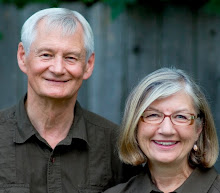The Leshan Giant Buddha is said to be the largest Buddha statue in the world, 71 meters, seated, carved from a cliff. People crowd around the face at the top, then climb down to the feet.
Looking up, Giant is the word. They say his fingernails are taller than an average human.
The next day we got up at 3:00 am to go to the top of Mount Emei, one of four sacred Buddhist mountains in China, with a golden statue of a 4-faced Buddha on top. It's best on a clear day when the mountain top is above the clouds and you can watch the sun rise, but the weather didn't cooperate for us, and we were in the clouds and mist. And with all the crowds it was long after sunrise when we got to the top, but no matter, we didn't even see the sun all day.Wednesday we got to sleep in until 4:00 am, before a short flight north from Chengdu to see Huanglong and Jiuzhaigou. Huanglong means "Golden Dragon" in Chinese, named for the colorful travertine formations and pools streching down an 8 km long valley. The tour bus stopped on the way up to buy altitude medication, since the elevation is high, over 11000 feet.
We sea-level dwellers were puffing, but the weather was sunny, and it was the most beautiful day of our Golden Week. The mountains of northern Sichuan connect with Tibet and host a similar culture.
The tour guide didn't speak English, but asked the Chinese tourists if anyone could help us. We were lucky to meet a young Chinese couple who quickly became friends as we realized how much we had in common, in spite of the age and culture differences.
Even more famous than Huanglong is Jiuzhaigou, Chinese for "Nine Villages Valley" with more travertine formations, waterfalls, and colorful lakes. We weren't as fortunate with the weather, although it didn't rain enough to keep us and thousands of Chinese tourists off the trails. But it was a long march getting there, including a 3-and-a-half hour traffic jam before we got to our hotel. Early mornings, long hikes, and late nights -- we don't think we can take much more of Chinese touring, and all the travel books suggest foreigners avoid Chinese holidays, but we joined the crowds for the same reason many Chinese do, it was the only time that we could get away from work.
Finally a chance to relax on Friday afternoon after the tour delivered us back to Chengdu. We wandered around a temple and garden at our own leisurely pace, then found a great Tibetan restaurant and had the best meal of our trip. Saturday was our first chance to sleep in, before flying back to our home province of Guangxi and catching the bus back to Qinzhou, where we put away the warm clothes and tour books, and are back to preparing lessons in the tropical south.








